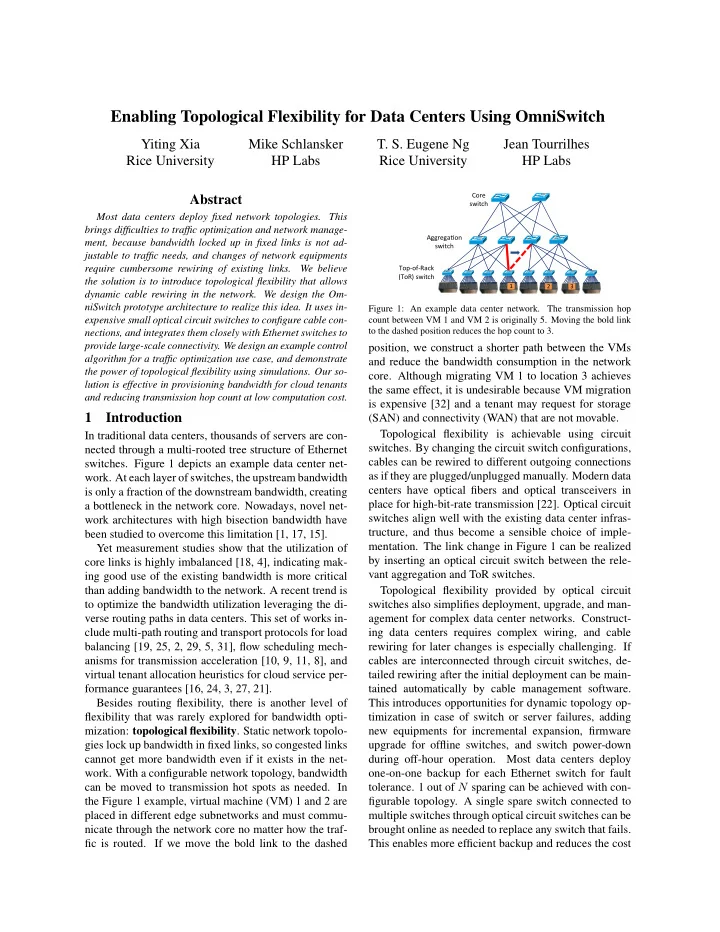

Enabling Topological Flexibility for Data Centers Using OmniSwitch Yiting Xia Mike Schlansker T. S. Eugene Ng Jean Tourrilhes Rice University HP Labs Rice University HP Labs Core) Abstract switch) Most data centers deploy fixed network topologies. This brings difficulties to traffic optimization and network manage- Aggrega&on) ment, because bandwidth locked up in fixed links is not ad- switch)) justable to traffic needs, and changes of network equipments require cumbersome rewiring of existing links. We believe Top3of3Rack) (ToR))switch)) the solution is to introduce topological flexibility that allows 3 1 2 3 dynamic cable rewiring in the network. We design the Om- niSwitch prototype architecture to realize this idea. It uses in- Figure 1: An example data center network. The transmission hop expensive small optical circuit switches to configure cable con- count between VM 1 and VM 2 is originally 5. Moving the bold link to the dashed position reduces the hop count to 3. nections, and integrates them closely with Ethernet switches to provide large-scale connectivity. We design an example control position, we construct a shorter path between the VMs algorithm for a traffic optimization use case, and demonstrate and reduce the bandwidth consumption in the network the power of topological flexibility using simulations. Our so- core. Although migrating VM 1 to location 3 achieves lution is effective in provisioning bandwidth for cloud tenants the same effect, it is undesirable because VM migration and reducing transmission hop count at low computation cost. is expensive [32] and a tenant may request for storage 1 Introduction (SAN) and connectivity (WAN) that are not movable. Topological flexibility is achievable using circuit In traditional data centers, thousands of servers are con- switches. By changing the circuit switch configurations, nected through a multi-rooted tree structure of Ethernet cables can be rewired to different outgoing connections switches. Figure 1 depicts an example data center net- as if they are plugged/unplugged manually. Modern data work. At each layer of switches, the upstream bandwidth centers have optical fibers and optical transceivers in is only a fraction of the downstream bandwidth, creating place for high-bit-rate transmission [22]. Optical circuit a bottleneck in the network core. Nowadays, novel net- switches align well with the existing data center infras- work architectures with high bisection bandwidth have tructure, and thus become a sensible choice of imple- been studied to overcome this limitation [1, 17, 15]. mentation. The link change in Figure 1 can be realized Yet measurement studies show that the utilization of by inserting an optical circuit switch between the rele- core links is highly imbalanced [18, 4], indicating mak- vant aggregation and ToR switches. ing good use of the existing bandwidth is more critical than adding bandwidth to the network. A recent trend is Topological flexibility provided by optical circuit to optimize the bandwidth utilization leveraging the di- switches also simplifies deployment, upgrade, and man- verse routing paths in data centers. This set of works in- agement for complex data center networks. Construct- clude multi-path routing and transport protocols for load ing data centers requires complex wiring, and cable balancing [19, 25, 2, 29, 5, 31], flow scheduling mech- rewiring for later changes is especially challenging. If anisms for transmission acceleration [10, 9, 11, 8], and cables are interconnected through circuit switches, de- virtual tenant allocation heuristics for cloud service per- tailed rewiring after the initial deployment can be main- formance guarantees [16, 24, 3, 27, 21]. tained automatically by cable management software. Besides routing flexibility, there is another level of This introduces opportunities for dynamic topology op- flexibility that was rarely explored for bandwidth opti- timization in case of switch or server failures, adding mization: topological flexibility . Static network topolo- new equipments for incremental expansion, firmware gies lock up bandwidth in fixed links, so congested links upgrade for offline switches, and switch power-down cannot get more bandwidth even if it exists in the net- during off-hour operation. Most data centers deploy work. With a configurable network topology, bandwidth one-on-one backup for each Ethernet switch for fault can be moved to transmission hot spots as needed. In tolerance. 1 out of N sparing can be achieved with con- the Figure 1 example, virtual machine (VM) 1 and 2 are figurable topology. A single spare switch connected to placed in different edge subnetworks and must commu- multiple switches through optical circuit switches can be nicate through the network core no matter how the traf- brought online as needed to replace any switch that fails. fic is routed. If we move the bold link to the dashed This enables more efficient backup and reduces the cost
Recommend
More recommend